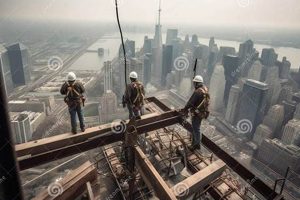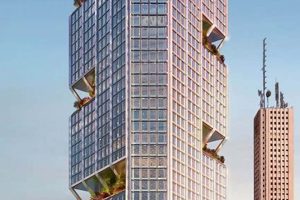“How tall is the skyscraper?” is a question that has fascinated people for centuries. Skyscrapers are some of the most iconic structures in the world, and their height is a major factor in their appeal. The tallest skyscraper in the world is the Burj Khalifa, which stands at 828 meters (2,717 feet) tall. This incredible height is made possible by a number of innovative engineering techniques, including the use of reinforced concrete and steel.
Skyscrapers are not just impressive feats of engineering; they also have a number of important benefits. For one, they can help to save space in densely populated urban areas. They can also be more energy-efficient than other types of buildings, as they can be designed to take advantage of natural light and ventilation. Additionally, skyscrapers can be used to create iconic landmarks that can help to define a city’s skyline.
The history of skyscrapers is a long and fascinating one. The first skyscrapers were built in the late 19th century, and they quickly became a symbol of progress and prosperity. In the early 20th century, skyscrapers began to be built in cities all over the world, and they soon became a common sight in major urban centers. Today, skyscrapers are an essential part of the urban landscape, and they continue to be built to new heights.
1. Height
The height of a skyscraper is one of the most important factors that defines it. Skyscrapers are typically defined as buildings that are over 150 meters (492 feet) tall, but there is no official definition. The height of a skyscraper is important because it affects the building’s design, construction, and maintenance. Taller skyscrapers require more engineering expertise to design and build, and they can be more difficult and expensive to maintain.
The height of a skyscraper can also have a significant impact on the surrounding environment. Taller skyscrapers can block sunlight from reaching the ground, and they can also create wind tunnels. This can make the area around a skyscraper less comfortable for people to live and work in.
Despite the challenges, there are also a number of benefits to building tall skyscrapers. Taller skyscrapers can provide more space for people to live and work in, and they can also be more energy-efficient than shorter buildings. Additionally, tall skyscrapers can be iconic landmarks that define a city’s skyline.
Ultimately, the decision of how tall to build a skyscraper is a complex one. There are a number of factors that need to be considered, including the building’s design, construction, maintenance, and environmental impact. However, the height of a skyscraper is one of the most important factors that defines it, and it can have a significant impact on the building and the surrounding area.
2. Engineering
The engineering of a skyscraper is a complex and challenging task. Skyscrapers must be able to withstand high winds, earthquakes, and other natural disasters. They must also be able to support the weight of the people and materials inside them. The height of a skyscraper can have a significant impact on the engineering challenges involved.
- Structural Engineering
The structural engineering of a skyscraper is one of the most important factors in determining how tall it can be built. The structural engineer must design the building to be able to withstand the forces of gravity, wind, and earthquakes. The taller the building, the greater the forces that it will be subjected to, so the structural engineer must use more innovative and sophisticated engineering techniques.
- Wind Engineering
Wind engineering is another important factor in the design of a skyscraper. The taller the building, the more exposed it is to wind. Wind can create a number of problems for skyscrapers, including swaying, buffeting, and vortex shedding. The wind engineer must design the building to be able to withstand these forces without causing damage or discomfort to the occupants.
- Seismic Engineering
Seismic engineering is the study of how to design buildings to withstand earthquakes. Earthquakes can be a major threat to skyscrapers, especially in areas that are prone to seismic activity. The seismic engineer must design the building to be able to withstand the forces of an earthquake without collapsing or causing serious damage.
- Fire Safety Engineering
Fire safety engineering is another important factor in the design of a skyscraper. Skyscrapers are at risk of fires, and the taller the building, the more difficult it is to evacuate the occupants in the event of a fire. The fire safety engineer must design the building to be able to contain a fire and allow the occupants to evacuate safely.
The engineering of a skyscraper is a complex and challenging task, but it is essential to ensure the safety of the occupants and the public. By understanding the engineering challenges involved, we can design and build skyscrapers that are both tall and safe.
3. Design
The design of a skyscraper is closely connected to its height. The taller the skyscraper, the more important it is to consider the building’s design. This is because taller skyscrapers are more visible and have a greater impact on the surrounding environment.
There are a number of design factors that need to be considered when building a skyscraper. These factors include:
- Height: The height of the skyscraper is one of the most important factors to consider when designing the building. The taller the skyscraper, the more complex the design will need to be.
- Shape: The shape of the skyscraper can also affect its height. Taller skyscrapers are often designed with a tapered shape to reduce wind resistance.
- Materials: The materials used to construct the skyscraper can also affect its height. Taller skyscrapers are often built with lightweight materials, such as steel and glass.
- Facade: The facade of the skyscraper is the exterior of the building. The facade can be designed to be aesthetically pleasing, as well as functional. For example, the facade can be designed to reflect sunlight and reduce heat gain.
The design of a skyscraper is a complex and challenging task. However, by carefully considering all of the factors involved, it is possible to design skyscrapers that are both tall and beautiful.
Here are some real-life examples of how design has been used to create tall skyscrapers:
- The Burj Khalifa is the tallest building in the world. It stands at 828 meters (2,717 feet) tall. The Burj Khalifa was
designed with a tapered shape to reduce wind resistance. The facade of the building is made of glass and steel, which reflects sunlight and reduces heat gain. - The Shanghai Tower is the second tallest building in the world. It stands at 632 meters (2,073 feet) tall. The Shanghai Tower was designed with a curved shape to reduce wind resistance. The facade of the building is made of glass and steel, which reflects sunlight and reduces heat gain.
- The One World Trade Center is the tallest building in the United States. It stands at 541 meters (1,776 feet) tall. The One World Trade Center was designed with a simple, rectangular shape. The facade of the building is made of glass and steel, which reflects sunlight and reduces heat gain.
These are just a few examples of how design has been used to create tall skyscrapers. By carefully considering all of the factors involved, it is possible to design skyscrapers that are both tall and beautiful.
4. Construction
The construction of a skyscraper is a major undertaking that can take years to complete. It requires a team of skilled workers to design, build, and maintain these towering structures. The height of a skyscraper is a major factor in determining the complexity and duration of its construction.
- Planning and Design
The first step in constructing a skyscraper is planning and design. This process can take months or even years, and it involves a team of architects, engineers, and other professionals. They must carefully consider the building’s height, shape, and materials, as well as the surrounding environment.
- Foundation
Once the plans are finalized, work can begin on the foundation. The foundation of a skyscraper must be strong enough to support the weight of the entire building. This can be a complex and time-consuming process, especially for skyscrapers that are built on soft or unstable ground.
- Structural Framework
The next step is to construct the structural framework of the skyscraper. This framework is made of steel or concrete, and it provides the building with its strength and stability. The structural framework of a skyscraper can be very complex, especially for taller buildings.
- Facade
The facade of a skyscraper is the exterior of the building. It can be made of a variety of materials, including glass, metal, and concrete. The facade of a skyscraper can have a significant impact on the building’s overall appearance and energy efficiency.
The construction of a skyscraper is a complex and challenging process, but it is essential to ensure the safety and stability of these towering structures. By carefully planning and designing the building, and by using high-quality materials and skilled workers, it is possible to construct skyscrapers that are both tall and safe.
5. Cost
The cost of a skyscraper is directly related to its height. Taller skyscrapers require more materials, labor, and engineering expertise to build. They also require more land, which can be expensive in densely populated urban areas.
- Materials
The cost of materials is a significant factor in the cost of a skyscraper. Taller skyscrapers require more materials, such as steel, concrete, and glass. The type of materials used can also affect the cost, with more expensive materials, such as stainless steel and exotic glass, driving up the cost of construction.
- Labor
The cost of labor is another major factor in the cost of a skyscraper. Taller skyscrapers require more workers to build, and these workers must be skilled in working at great heights. The cost of labor can also vary depending on the location of the skyscraper, with labor costs being higher in major urban areas.
- Engineering
The cost of engineering is also a significant factor in the cost of a skyscraper. Taller skyscrapers require more complex engineering to design and build. This engineering must ensure that the building can withstand high winds, earthquakes, and other natural disasters.
- Land
The cost of land is also a factor in the cost of a skyscraper. Taller skyscrapers require more land, which can be expensive in densely populated urban areas. The cost of land can also vary depending on the location of the skyscraper, with land being more expensive in prime locations.
The cost of a skyscraper can vary significantly depending on its size, design, and location. However, the cost of a skyscraper is always a major factor in determining how tall it can be built.
6. Maintenance
The height of a skyscraper can have a significant impact on the maintenance costs. Taller skyscrapers require more maintenance than shorter buildings. This is because taller buildings are more exposed to the elements, and they experience greater wind loads and seismic forces. As a result, taller skyscrapers require more frequent inspections and repairs.
The type of maintenance that is required for a skyscraper will vary depending on its age, design, and location. However, some of the most common maintenance tasks include:
- Inspection of the building’s facade and structural components
- Cleaning and repair of the building’s windows and exterior surfaces
- Replacement of worn or damaged building materials
- Upgrading of building systems, such as the HVAC system and electrical system
The cost of maintenance for a skyscraper can be significant. However, this maintenance is essential to ensure the safety of the people who live and work in skyscrapers. By properly maintaining skyscrapers, we can help to ensure that these iconic structures continue to be safe and habitable for years to come.
7. Impact
The height of a skyscraper can have a significant impact on its impact on the city in which it is built. Taller skyscrapers are more visible and have a greater presence in the skyline. This can make them a symbol of the city and a source of pride for its residents. For example, the Burj Khalifa is the tallest building in the world and has become an iconic landmark of Dubai.
Skyscrapers can also create new jobs. The construction of a skyscraper requires a large workforce, and once the building is completed, it will need to be maintained and operated. This can create thousands of jobs in the city. For example, the construction of the One World Trade Center in New York City created over 40,000 jobs.
Finally, skyscrapers can boost the economy of a city. They can attract tourists and businesses, and they can increase the value of land in the surrounding area. For example, the construction of the Petronas Towers in Kuala Lumpur helped to make the city a major tourist destination.
The impact of a skyscraper on a city is not always positive. Skyscrapers can block sunlight and create wind tunnels. They can also be expensive to build
and maintain. However, when they are planned and designed carefully, skyscrapers can be a valuable addition to a city.
FAQs
This section addresses frequently asked questions about skyscraper heights in a clear and informative manner, providing valuable insights.
Question 1: How is the height of a skyscraper measured?
The height of a skyscraper is typically measured from the ground to the top of the architectural structure, including spires, antennas, and other permanent fixtures. However, there is no universally accepted standard for height measurement, leading to variations in reported heights for some buildings.
Question 2: What are the factors that determine the height of a skyscraper?
Several factors influence a skyscraper’s height, including engineering capabilities, architectural design, material strength, wind loads, and local building regulations. Taller buildings require advanced engineering solutions and robust materials to withstand the increased forces and maintain structural integrity.
Question 3: What is the tallest skyscraper in the world?
As of 2023, the Burj Khalifa in Dubai holds the title of the tallest skyscraper globally, standing at an impressive 828 meters (2,717 feet) tall.
Question 4: Are there any height limits for skyscrapers?
Building height limits vary across cities and countries. Some jurisdictions impose restrictions due to factors like airspace safety, visual impact, or environmental concerns. However, advancements in engineering and design continue to push the boundaries of what is considered feasible.
Question 5: What are the advantages of building tall skyscrapers?
Skyscrapers offer several advantages, including efficient land utilization, increased floor space, panoramic views, and potential energy savings through optimized designs. They can also serve as iconic landmarks and contribute to a city’s skyline.
Question 6: Are there any drawbacks to building extremely tall skyscrapers?
While skyscrapers offer many benefits, constructing and maintaining extremely tall buildings presents challenges. These include increased construction costs, complex engineering requirements, potential wind-related issues, and the need for specialized safety measures during construction and operation.
In conclusion, skyscraper heights are influenced by a combination of factors, with the tallest buildings showcasing remarkable feats of engineering and architectural innovation. As technology advances and building practices evolve, the pursuit of constructing even taller structures may continue to shape the skylines of cities worldwide.
Transition to the next article section:
Tips on Skyscraper Height Considerations
Understanding skyscraper height involves more than just knowing the tallest buildings. Careful planning and various factors come into play. Here are some informative tips to enhance your knowledge:
Tip 1: Height Measurement Variations
Skyscraper heights can vary depending on measurement methods. Some consider the architectural top, while others include antennas or spires. Understanding these variations helps ensure accurate comparisons.
Tip 2: Engineering and Design Influence
The height of a skyscraper is influenced by engineering capabilities and design choices. Advanced engineering solutions and innovative designs allow for taller structures to withstand forces like wind and seismic activity.
Tip 3: Material Strength and Selection
The choice of materials plays a crucial role in determining skyscraper height. Stronger materials, such as reinforced concrete and high-grade steel, enable the construction of taller buildings by providing structural stability.
Tip 4: Local Building Regulations
Building height regulations vary by location. Factors like airspace safety, visual impact, and environmental concerns influence these regulations, impacting the maximum allowable height of skyscrapers in specific areas.
Tip 5: Advantages of Building Tall
Skyscrapers offer advantages such as efficient land use, increased floor space, and potential energy savings. They can also serve as iconic landmarks and enhance a city’s skyline.
Tip 6: Challenges of Extreme Height
While skyscrapers provide benefits, constructing and maintaining extremely tall buildings come with challenges. These include increased construction costs, complex engineering requirements, and the need for specialized safety measures.
Remember, skyscraper height is not just about reaching new records but also about balancing engineering, design, and practical considerations. Understanding these tips can provide a more comprehensive understanding of how and why skyscrapers reach impressive heights.
Transition to the article’s conclusion:
Conclusion
The exploration of “how tall is the skyscraper” has revealed the intricate interplay of engineering, design, and practical considerations that shape these architectural marvels. Skyscrapers have transformed skylines, revolutionized construction techniques, and continue to push the boundaries of human ingenuity.
Understanding the factors that determine skyscraper height provides valuable insights into the challenges and advancements in modern architecture. From the influence of materials and engineering capabilities to the impact of local regulations and sustainability concerns, a comprehensive perspective is essential to appreciate the complexities involved.
As we look to the future, the pursuit of constructing even taller skyscrapers will undoubtedly continue. However, it is imperative to balance this ambition with careful planning and a commitment to sustainable and responsible practices. By embracing innovative technologies and fostering collaboration between architects, engineers, and urban planners, we can create skyscrapers that not only reach new heights but also contribute positively to our cities and the environment.







